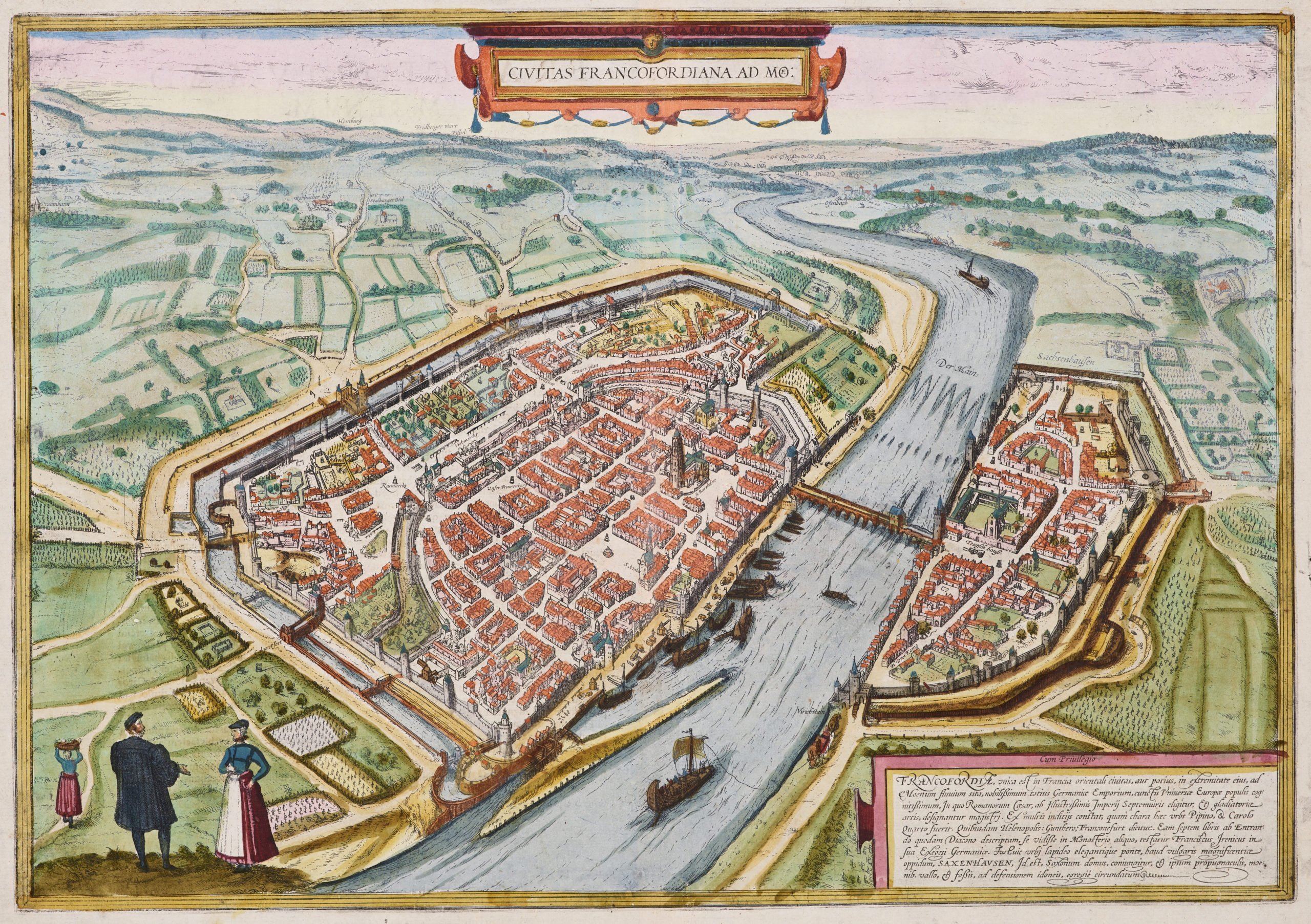Frankfurt
Detail
Date of first edition: 1572
Date of this edition: 1574
Dimensions (not including margins): 33 x 47 cm
Condition: Very good, strong copper engraving with lovely original colouring and wide margins.
Condition rating: A+
Verso: text in Latin
Map reference: Van der Krogt 4, 1361;Taschen, Br. Hog., p. 95
From: Civitatis Orbis Terrarum (Liber primus, first edition 1572, this edition 1574). Koeman B&H1.
In stock
Frankfurt commented by Braun
“The largest and most magnificent part of the city is called Frankfurt, the other Sachsenhausen, which is also surrounded by walls and moats. Frankfurt is a leading centre of trade not just in Germany but in Europe. For twice a year, before Easter, in the middle of Lent, and in autumn, large numbers of merchants come from Lower and Upper Germany and from many other parts of the world to the annual fairs here. Emperor Charles IV also had a particular liking for this city, and therefore he moved the election of the kings and emperors of the Romans to here and confirmed this in his Golden Bull.”
Translation of cartouche text: Frankfurt is a unique city in East Franconia, or rather, at its extremity, lying on the Main, the most famous trade city in all Germany, very well known amongst all the peoples of Europe; the Roman Emperor is elected here by the most illustrious College of Seven, the Electors, and the fencing masters designated. […] In his treatise on Germany, Franciscus Irenicus attests that he has seen in a monastery a description of Frankfurt in seven books, written by a deacon named Entrandus. Connected to Frankfurt by an elegant stone bridge is Sachsenhausen, a town of no ordinary magnificence. Frankfurt is surrounded by bulwarks, walls, ramparts and moats that are exceptionally well designed for defensive purposes.
Full title: Civitas Francofiordiana Ad Mo:
Taschen on Frankfurt
An impressive bird’s-eye view from the southwest of the powerful trade city of Frankfurt, in 1605 home to 20,000 people. St Batholomew’s cathedral, coronation church of the German kings and emperors, stands on the hill at the core of the original settlement on the right bank of the Main. On the Römerberg hill further left, the Römer and Goldener Schwan houses served as the town hall from 1405 onwards; to their right lies the Gothic councillors’ church of St Nicholas. Identified in the Sachsenhausen quarter are the church of the Magi (H. Drei Konig), which became Frankfurt’s first Protestant church in 1525, and the house of the Teutonic Knights (Teutsch Hauss). Frankfurt had been established as an international trade-fair centre and city of commerce in the Middle Ages: its autumn fair had been running since the 12th century and the spring fair since 1330. By around 1600 the book fair in this publishing city had already assumed international proportions. Frankfurt’s commercial and fair activities meant that countless different currencies were in circulation. Around 1585 exchange rates and rules of trade were introduced, in a move seen as marking the birth of the Frankfurt stock exchange. In 1147 Frankfurt was also assured a special position within the Empire, as the site of the election of German kings, a role officially confirmed by the Golden Bull of 1356; from 1562 to 1792 the coronation of the Emperor also took place in Frankfurt cathedral.
Related items
-

Frankenberg (Hesse) – Francenbergum, vel ut alij Francoburgum Hassiae Opp.
by Georg Braun and Frans HogenbergPrice (without VAT, possibly to be added): €400,00 / $444,00 / £356,00 -

Marburg and Kassel (Hesse)
by Georg Braun and Frans HogenbergPrice (without VAT, possibly to be added): €600,00 / $666,00 / £534,00




